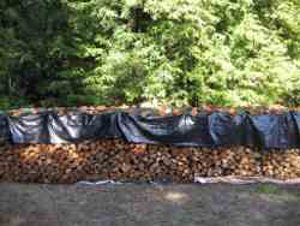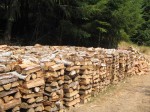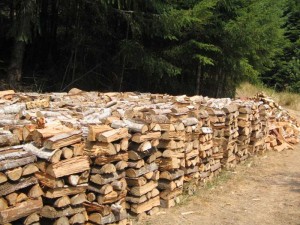Why Stack Firewood?
When you get a load of firewood the natural thing to do is stack it. But why do we stack it instead of leaving it in a big heaping pile? Although you could leave it in a pile, there are advantages to stacking firewood.
Firewood stacking is a good way to get your firewood off the ground and in a position where it can get good air circulation. This will allow it to dry faster, help it stay dry,and makes it easier to cover. Stacked firewood also takes up less space than a random pile and looks nicer. More about how to season firewood.
Firewood Stacking
Firewood stacking may seem like a simple job, and it is, but learning how to stack firewood can give you better quality firewood to burn and save you from a lot of unneeded work and potential problems.
Where to Stack Firewood
Stacking your firewood in the right place can save you a lot of work and help your wood dry. If your wood is green or wet, the best place to stack it is outdoors where it can be exposed to the sun. If it is dry, it’s best to stack it under cover in a shed, lean-to or other structure that is well ventilated. Covering firewood with a tarp works too when done properly.
If your firewood is wet or green, you can still stack it indoors, just be sure the structure has good air flow so it can dry. And know it may take longer to dry than if it was out in the sun.

If your wood is dry, and you don’t have a structure to put it in, you can stack it outdoors and cover it with a tarp or plastic sheeting, or other material to keep it dry. Just make sure you cover it in a way that allows air flow. Leave the sides of the stack exposed to the open air. If you put a tarp over the whole pile all the way to the ground it will hold in moisture.
See why covering your wood with metal roofing is a great way to keep it dry.
In selecting a place for your firewood keep in mind how convenient it will be to bring in to burn. Consider that it will probably be there a while and think of things you might be doing later and whether it might be in the way.
Check with local building and fire codes, in some areas outdoor firewood is recommended or required to be stored a certain distance from structures for fire safety.
How to Stack Firewood
When firewood stacking you will want to keep it off the ground. If you are stacking it on a hard floor or concrete slab that is fine but you can put stickers down to help air flow under the stack. If you are stacking it directly on the ground you will definitely want to put something on the ground first to keep the wood away from soil contact. Two parallel 2×4’s or similar objects placed the length of the firewood apart work great.

If you are stacking against a wall, fence or other structure leave a few inches space to allow air flow. Also if you are making multiple stacks keep a few inches of space between the stacks.
Start stacking the pieces fitting them together as tightly as you can to make the pile stable. Notice the taper of the wood and invert the pieces so thick ends can be next to thin ends as needed so the pieces fit together well. Stack the pieces with the ends as even as you can to ensure a vertical stack. For a more stable stack keep the it no more than 4′ high or it could become unstable and fall over.
If you have a firewood rack or stakes at the ends or something to stack the ends against this will help you get nice vertical ends to your stack. If not you can criss-cross flat edged pieces like a log cabin on the ends to make them vertical. Otherwise you can just slope the ends but make sure the slope isn’t too steep or you may end up with a firewood avalanche. This can be dangerous especially if there are small kids or pets around. How to build a firewood rack that is simple and inexpensive.
Keep in mind that wood shrinks as it dries and the stacks may shift some over time. If one side gets sun exposure that side will shrink faster and can cause the stack to lean in that direction. When stacking green wood you may want to stack it so it leans a little away from the sun to compensate. Same with stacking against a wall or against other stacks. The out facing side of the stack will often dry faster and lean away toward the open space.
Keep safety in mind when firewood stacking and know that woodpiles can fall over. Keep children off of them.


Hi,
I have a question. I have my wood stacked outside, criss crossed on pallets. I have a heavy duty plastic sheeting over just the tops of the wood in spring and summer. I was wondering when it gets colder, and possibly snows, should I adjust the sheeting to cover the sides of the wood too? To keep the snow out? Or would that just be a breeding ground for moisture/mold etc.? Any advice would be awesome!
Thanks,
Dan
If the idea is to get the firewood air circulation to dry it out, then stacking in nice tight orderly piles aint gonna do it. Just leaving it in a big disorganized pile with maximum surface area exposed to the air is best, will dry the quickest, and is by far the easiest to manage.
Daniel — No I would not pull the plastic sheeting over down the sides of your stack, you’ll not have any air circulation and more importantly you’ll get condensation and the wood will retain moisture. Believe me, I tried it and when I finally checked under the tarp I was disappointed to find all the moisture. It set the curing of that wood back months.
Most of my wood is dried in a pile and not a stack. That’s just because when dealing with commercial quantities of wood, the massive amount of labor to stack it all just doesn’t pay. But if I do stack some, it always dries faster, as long as there is air space on both sides of the stack. When stacked this way, you actually have better air circulation than a heaping pile. Also there are fewer pieces in contact with the ground.
With a heaping pile the wood on top dries faster but the wood in the middle of the pile takes much longer to dry. Often I will take the dry top layer off that has been exposed to the sun and air and sell it. Then I have to wait sometimes months for the wood below to dry. The exception to this is a pile that is not very deep and spread out.
We cover the sides of our wood with a tarp… works fine for us.
In many climates and situations you can get away with it just fine with wood that is already dry. But in many conditions it can cause problems.
Been burning 5-13 cords of wood every year for 60 plus yrs,,and believe me, wood dries much faster when stacked,,i purposely buy “wet”,or newly cut wood as it is usually much cheaper to buy..the wood guys know they cant sell it if its wet,,so i buy wood one yr in advance cheap, and stack it wet..i only use hardwood,,oak,or others.and i can start it after a yr, with just a wad of newspapers..as to the covering it,,people in rain every day, or snow everyday situations need to cover it, but in the high desert we don cover,,,hope this helps..hey, cosy up to the fire, and save all that natural gas bill money for Vegas..
I still don’t understand what you stack wood on to. Won’t it draw termites if it’s on the ground or even a 2 x 4 touches the ground? Or on the ground, doesn’t it draw moisture or other bugs. Short of concrete, I just don’t understand putting wood on the ground.
Yes the 2x4s or other wood that you put on the ground will draw moisture, bugs, and will likely rot after a few years. But that’s ok, just replace it. It’s better to have that on the ground rotting than your firewood. Wood is not the ideal material to put on the ground to stack firewood on but it’s cheap and abundant so it’s the common choice. If you want something permanent that you don’t have to replace, concrete would be a better choice than wood.
I use wooden pallets, the ones i have right now are starting their 4th season and doing fine. I have always covered my dry wood completely in winter, in fact i have a tarp over the top of the wood, and then another bigger tarp over the whole thing and wrapped like a Christmas present. The wood is completely unwrapped during spring and summer. Haven’t had a problem. I get alot of rain in the winter. I’m no expert, I’ve been burning wood for about 6 years, but have a tiny stove and only burn at night so i only go thru a cord or so a winter.
I generally begin cutting red and white oak, wild cherry, and hickory in about July, sometimes as early as June. Storms here in east central Georgia help me decide. I manage my own woodlot on my property, and try to cut only the trees that have been downed or severely damaged during these summer storms.
I have a 22″ opening on the woodstove, so all of my wood is cut to 20″. All wood is stacked off of the ground, outside without covering during the summer, placing the bark upwards if possible. Generally, all of the wood is dry by November when our cold weather sets in. Our Winters are the rainy season, so I generally cover with heavy duty plastic as the rains begin.
I have been burning and stacking wood most of my life.Isabel a few tears back gave us enough to last until Irene. Now I am spiting red oat some of prettiest firewood I have spit cause most fo the time I get the knots or the junt nobody else wants.
But this time old Ralph got a whole full grown red oak I am im
loving it.By the I get all of this on the yard and spit and stacked it will probely last till the next storm that will
knck down some red oak.Hope everybody is Happy
Been logging/tree service for over 40 years. I always cut wood to 16″ lengths as most people in my area (Iowa) don’t want it longer. That make a full cord, 3 rows deep by 4′ high and 8′ long….128 cu. ft…..If they do want it longer, I’ll cut to whatever length/size they want. Stacking: The “old” rule of thumb I was raised up by is to leave a space/hole between the stacked pieces big enough for a squirrel to barely squeeze through but small enough that a rabbit can’t..stack all pieces the same direction on pallets preferably…….better air circulation and stays really stable that way…….when I deliver, I stack the wood tight thereby giving almost 2/3 cord of tightly stacked wood in a regular pickup truck box (6’W x8’L x 1.75’H = ~ 84 cu ft) ..that’s 6 rows long when cut at 16″…a little more room when stacked with airspace and more than 1/2 cord/72 cu. ft……….wood is all hardwoods (tops/limbs/trunks)left whole for 1 1/2 to 2 years (depending on deadness of tree when taken down)then bucked to 16″ pieces and split…….moisture content runs from 12% to 16% when delivered………..no infested/diseased or softwoods sold for firewood……..and a lot of people do buy the green wood (softwood only) off some of the job sites if I find it safe enough for them to do without my supervision…..I even deliver green loads (softwoods only) at a reduced price also………..no need to waste any parts of the tree unless infested/diseased…………
I am agree with you that stack firewood can give you better quality firewood to burn and save you from a lot of unneeded work and potential problems.
From my point of view . This kind of wood should be banned by the Govt. because it is very bad effect on our nature.
How is it bad for nature?
The comment above by “Mining Services” is an example what results from years of exposure to the misinformed nonsense peddled by radical environmentalists.
Let me try to “clear the air” (pardon the pun) for anyone else who may be poisoned by that type of thinking;
Since the topic at hand is stacking firewood, I will assume that the fuel (wood) has been seasoned, and is dry and burns with reasonable efficiency. With that in mind, one cord of firewood provides the heat roughly equivalent to that produced by burning 100 to 150 gallons or more of heating oil, depending on the species of wood you’re using.
Therefore, wood combustion replaces the consumption of fossil fuels, and since wood is a conditionally renewable fuel, using wood instead of oil should be right up the environmentalists’ alley, but logic doesn’t seem to be their strong suit.
Burning wood is nearly carbon neutral because trees absorb CO2 as they grow. When trees mature and fall in the forest and decompose there, the same amount of CO2 is emitted as would be released if they were burned for heat. In heating your house with wood, you are simply tapping into the natural carbon cycle in which CO2 flows from the atmosphere to the forest and back, so it is much better for the environment than other fuels, especially in a modern wood stove that produces very little smoke.
Also, by clearing the forest of dead, damaged or diseased trees, the quality of the stand and wildlife habitat are enhanced, as well as having the added bonus of substantially reducing the scale and ferocity of forest fires, making them more easily contained – saving lives and property.
Serious analysis shows the limitations of solar, wind, hydro, et al. as producers of the bulk heat needed to warm houses in moderate to cold climates. So folks like “Mining Services” above need to re-evaluate their world-view and become smarter, more responsible citizens.
I envy you americans who can depend on the seasons…. Spare a thought for us Irish….. Wet Winters AND wet Summers…. Just cut and stacked wood for the first time.. recently installed a stove….. Wondering if the wood will ever dry!!!
I’ve been burning and stacking wood for 30 years and I’ve learned a few things. I make 2X4 pressure treated frames that are 14 inches wide by 8 feet long. I don’t stack any higher than 4 feet or I’ll be restacking it when it falls. These frames last for ever and get the wood off the ground. I’ve also learned to make stacks in twos so there adequate air circulation and it catches leaf debris. If you stack ten rows of wood side by side air doesn’t circulate as well. I only cover the wood that I think I’ll be using within 6 to 8 weeks and the rest is left uncovered. I generally have 2-3 years of wood so it’s certainly seasoned when I burn it. I get minimal creosote build up. I never go out of my way to cut wood it simply finds me following wind storms or soft ground from rainstorms. I burn aprox. 4-5 cords of wood a year heating my house and shop with stoves. I split with a hydraulic splitter and cut with an 18″ MS 260 Stihl Pro.
Nolan: According to the National Wildlife Federation dead and downed trees provide vital habitat for many species so not removing all of them is actually better for biodiversity as long as they are not diseased. “By some estimates, the removal of dead material from forests can mean a loss of habitat for up to one-fifth of the animals in the ecosystem.”
http://www.nwf.org/How-to-Help/Garden-for-Wildlife/Gardening-Tips/Attracting-Wildlife-With-Dead-Trees.aspx
This is a very good point you bring up Asha. It’s a good idea to leave snags and downed wood where appropriate. Also good to learn which types of trees and wood are the the best to leave for wildlife habitat and which are just as well to be used for firewood.